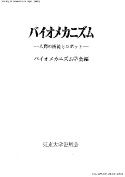16 巻
選択された号の論文の24件中1~24を表示しています
- |<
- <
- 1
- >
- >|
1部 生体計測
-
原稿種別: その他
専門分野: その他
2002 年 16 巻 p. 13-25
発行日: 2002年
公開日: 2004/09/01
PDF形式でダウンロード (2126K) -
原稿種別: その他
専門分野: その他
2002 年 16 巻 p. 27-35
発行日: 2002年
公開日: 2004/09/01
PDF形式でダウンロード (1064K) -
原稿種別: その他
専門分野: その他
2002 年 16 巻 p. 37-46
発行日: 2002年
公開日: 2004/09/01
PDF形式でダウンロード (1123K) -
原稿種別: その他
専門分野: その他
2002 年 16 巻 p. 47-59
発行日: 2002年
公開日: 2004/09/01
PDF形式でダウンロード (1698K) -
原稿種別: その他
専門分野: その他
2002 年 16 巻 p. 61-73
発行日: 2002年
公開日: 2004/09/01
PDF形式でダウンロード (993K) -
原稿種別: その他
専門分野: その他
2002 年 16 巻 p. 75-85
発行日: 2002年
公開日: 2004/09/01
PDF形式でダウンロード (1968K) -
原稿種別: その他
専門分野: その他
2002 年 16 巻 p. 87-99
発行日: 2002年
公開日: 2004/09/01
PDF形式でダウンロード (1658K) -
原稿種別: その他
専門分野: その他
2002 年 16 巻 p. 101-113
発行日: 2002年
公開日: 2004/09/01
PDF形式でダウンロード (1535K)
2部 運動特性
-
原稿種別: その他
専門分野: その他
2002 年 16 巻 p. 117-128
発行日: 2002年
公開日: 2004/09/01
PDF形式でダウンロード (1254K) -
原稿種別: その他
専門分野: その他
2002 年 16 巻 p. 129-141
発行日: 2002年
公開日: 2004/09/01
PDF形式でダウンロード (1182K) -
原稿種別: その他
専門分野: その他
2002 年 16 巻 p. 143-154
発行日: 2002年
公開日: 2004/09/01
PDF形式でダウンロード (1577K) -
原稿種別: その他
専門分野: その他
2002 年 16 巻 p. 155-165
発行日: 2002年
公開日: 2004/09/01
PDF形式でダウンロード (1757K) -
原稿種別: その他
専門分野: その他
2002 年 16 巻 p. 167-181
発行日: 2002年
公開日: 2004/09/01
PDF形式でダウンロード (1944K) -
原稿種別: その他
専門分野: その他
2002 年 16 巻 p. 183-194
発行日: 2002年
公開日: 2004/09/01
PDF形式でダウンロード (1200K) -
原稿種別: その他
専門分野: その他
2002 年 16 巻 p. 195-205
発行日: 2002年
公開日: 2004/09/01
PDF形式でダウンロード (1702K) -
原稿種別: その他
専門分野: その他
2002 年 16 巻 p. 207-220
発行日: 2002年
公開日: 2004/09/01
PDF形式でダウンロード (1609K)
3部 モデル解析
-
原稿種別: その他
専門分野: その他
2002 年 16 巻 p. 223-230
発行日: 2002年
公開日: 2004/09/01
PDF形式でダウンロード (1124K) -
原稿種別: その他
専門分野: その他
2002 年 16 巻 p. 231-241
発行日: 2002年
公開日: 2004/09/01
PDF形式でダウンロード (842K) -
原稿種別: その他
専門分野: その他
2002 年 16 巻 p. 243-252
発行日: 2002年
公開日: 2004/09/01
PDF形式でダウンロード (890K) -
原稿種別: その他
専門分野: その他
2002 年 16 巻 p. 253-266
発行日: 2002年
公開日: 2004/09/01
PDF形式でダウンロード (1449K) -
原稿種別: その他
専門分野: その他
2002 年 16 巻 p. 267-274
発行日: 2002年
公開日: 2004/09/01
PDF形式でダウンロード (927K) -
原稿種別: その他
専門分野: その他
2002 年 16 巻 p. 275-284
発行日: 2002年
公開日: 2004/09/01
PDF形式でダウンロード (871K) -
原稿種別: その他
専門分野: その他
2002 年 16 巻 p. 285-299
発行日: 2002年
公開日: 2004/09/01
PDF形式でダウンロード (1947K) -
原稿種別: その他
専門分野: その他
2002 年 16 巻 p. 301-308
発行日: 2002年
公開日: 2004/09/01
PDF形式でダウンロード (1407K)
- |<
- <
- 1
- >
- >|
